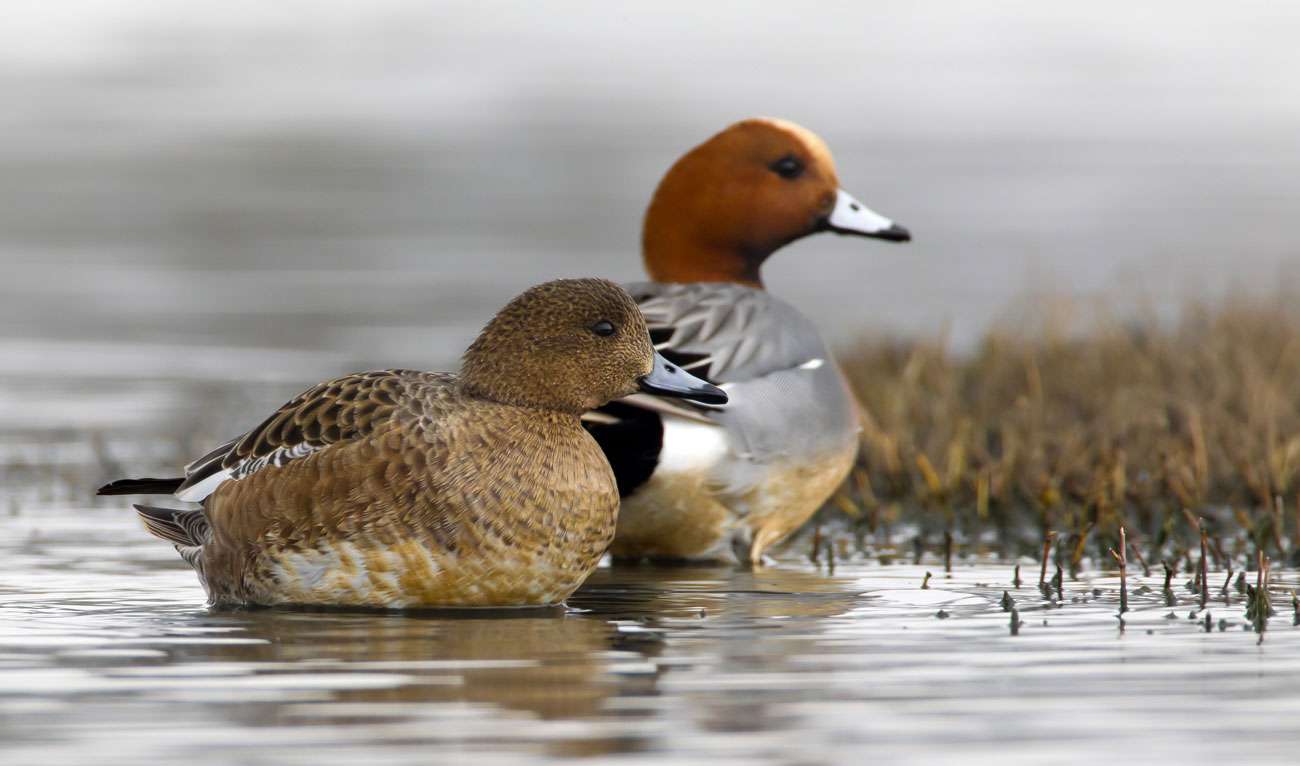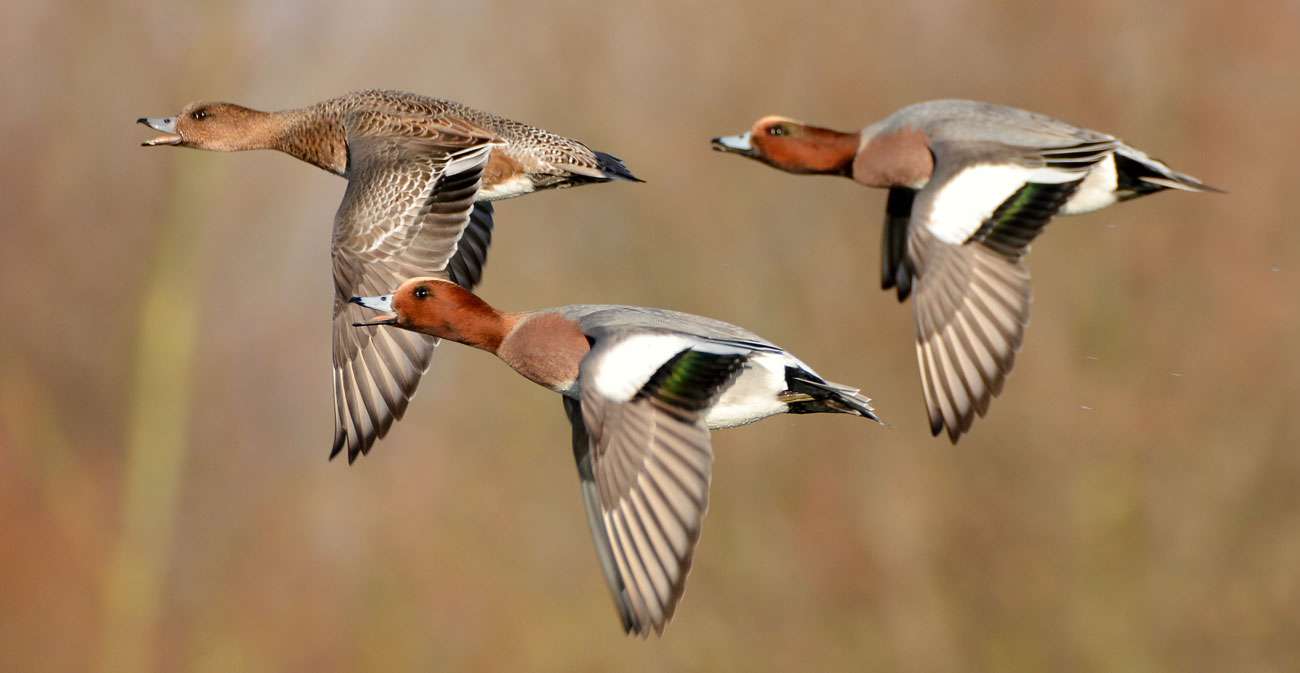
Biggest surprise of the year: Wigeon (Anas penelope). Nice change from the Pigeon! Here’s a pair. I never saw mine – just heard them flying over calling at night
With the RSPB’s big garden birdwatch swinging into action from 28-30 January many of us will be counting the birds seen for an hour in our very own observatories.
I considered my effort last year less than impressive – just 28 birds of ten species. Nine were House Sparrows. So I thought I would look back on the year just passed to see how many different species either went over my Cranleigh garden or landed in it.
The following provides an idea of what you might expect to see or hear if you decide to make a garden list for 2022, which I encourage you to do for a bit of fun.
The year 2021 started for me with only nine bird species on 1 January – Woodpigeon, Goldfinch, a wintering female Blackcap, Magpie, House Sparrow, Collared Dove, Blue Tit, Starling and an early-singing Mistle Thrush.
Next day I recorded Dunnock, a flyover Cormorant, Great Tit, Robin, Jackdaw, Blackbird and Crow. On 3 January a Song Thrush was on the lawn and a Wren hopped along the fence. Three nervous Redwings used my plum tree next day as a base for quick forays to nearby cotoneaster berries.
Species number 20 were an often seen and heard flock of Greylag Geese passing overhead, followed next day by a flyover Herring Gull and a Black-headed Gull. A Common Buzzard was also detected gliding over the trees, a Nuthatch visited the feeders and a raucous Jay jumped around in the oak trees.
A Great spotted Woodpecker appeared on the 7th followed three days later by our tiniest bird, the Goldcrest. Next day one of our biggest went over – a Red Kite. Towards the evening a Tawny Owl called and a Long-tailed Tit arrived at the feeders.
A Grey Heron flew majestically by on the 13th and there were two new birds on the 16th, a Green Woodpecker and a Sparrowhawk – one of many sightings over the garden during the year. Taking me to the end of January were a Rook and Feral Pigeon, a Coal Tit on the peanuts, and Canada Geese then flew over on 22nd January.
A lull followed, broken at last by a winter visitor, the Fieldfare on 18 February. Next day there was a Lesser Black-backed Gull and a flyby Mallard, followed on the 20th by a Greenfinch and then Siskin – formerly a winter visitor but increasingly seen around here in all seasons. Chaffinch on the 28th saw out the month, taking me to 40 species.
A Pheasant, a rare visitor to my part of the village, appeared lost on the front lawn on the 2nd of March while two weeks later I saw a Stock Dove whizzing by, plus a bounding Pied Wagtail. In the evening I detected the first calls of the year from Little Owl. Four more birds were added before the end of the month – Linnet, Mandarin, Raven and – oh joy – the first returning summer migrant of the year – a calling Chiffchaff.
They say one Swallow doesn’t make a summer but on 9 April one flew over the garden and let me know the change of season was truly underway. I’d seen my first of the year over a Cranleigh field on my earliest ever local date – 27 March. Global warming?
A Great black-backed Gull flew by the same day and a week later a migrant from the southern oceans appeared above – a Common Tern. There have been increasing numbers of this species in recent years and this was my first of two sightings over the garden in 2021. Summer for me is not here until the first Swift, and one early one duly obliged on the 27th.

Wigeon (Anas penelope)
May disappointingly provided only one new species – a House Martin on the 9th. They are often quite late here compared to other areas.
I was pleased on 2nd June to hear a distant Cuckoo. It was the first of this amazing species from my garden in two years. But the only other new bird that month was a Bullfinch, on the 25th.
A month went by before I heard a Moorhen calling, on 21 July, from Summerlands Pond, and I was pleased to see a darting Hobby hunting – unsuccessfully – among a whirling mass of 70 Swift on the same day.
Willow Warblers had begun their Autumn trip back to Africa by 14 August and that is when I heard one calling in the garden hedge. An Egyptian Goose flew over on the 30th, calling strongly among a flock of Canada and Greylag Geese.
It took until 28th September for Grey Wagtail to finally put in a showing but that was my only bird that month, taking me to 60 species. Autumn migration brought me a passing Meadow Pipit on 7th October, and a flock of nine wheezing Brambling circled the garden briefly early next day, the first for several years. The first of migrating Skylarks were noted from the 9th. From the garden I used to hear them singing in the breeding season but a new housing estate wiped them out.
All went quiet for over a month but on the evening of 24 October, as I put our King Charles Cavalier Bobby outside for a pee, I was delighted to hear a Wigeon calling as it headed north in the dark. There were three calls so it was at least one, or as many as three – or more. That brought me to number 67 for the year and took my all-time garden list to 107.
In November I tried to increase coverage in the hope of connecting with some on my ‘missing’ list. I was rewarded on 13 November with number 68, a calling Lesser Redpoll bounding north.
Those I still hope for as I write in dark early December to meet an early deadline include a fly-by Kestrel, Peregrine, Little Egret, Common Gull (they ain’t round here) and Ring-necked Parakeet. A little freeze could bring in something more exciting.
Meanwhile I await autumn’s last leaves to fall to make it easier to see a much-expected Tree Creeper. I’ll let you know how I finished next month.
Twitter – @Crane_Spotter
Click here to see all of Robin Stride’s previous Crane Spotters.











